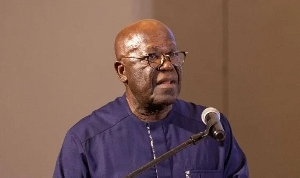The USAID-funded West Africa Fertiliser Programme (WAFP) has organised a field demonstration of the Urea Deep Placement (UDP) fertiliser technology for rice farmers at Dadome in the Volta Region.
The field exhibition was to demonstrate the positive results of the application of the technology to the Mawuko Farmers Association and other farmers, the Ministry of Food and Agriculture (MOFA) and stakeholders.
Urea Deep Placement, a technology developed by International Fertiliser Development Centre (IFDC), is the more effective method of applying urea briquettes deep into the soil in contrast to the traditional method of surface broadcasting.
Speaking on the occasion, Dr Kofi Debrah, Chief of Party of WAFP, said fertiliser use accounts for 30 per cent of the global increase in cereal yields over the last three decades.
He said African leaders had identified fertiliser to be the cornerstone for increasing agricultural productivity and had resolved at the Fertiliser Summit in Abuja to ensure farmers use 50 kg per hectare as against the current use of 10kg per hectare.
Dr Debrah said besides cost and access to fertilisers, farmers in Ghana use a single fertiliser recommendation which they apply irrespective of the fertility status of the soil and agro-ecology.
“As a result farmers experience poor returns and there is a critical need for tailored fertilisers that meet specific soils and agro-ecology needs,” he said.
He expressed his pleasure at the introduction of the technology to the Volta Region for the first time, adding: “The UDP technology was introduced in Northern Ghana in 2012 but through the Mawuko Farmers’ Association, the technology has come to the Volta Region for the first time.”
Mr Ferguson Afeletey, Leader of Mawuko Farmers Association, explained to other rice farmers that the new technology ensures efficient fertiliser usage, leading to increased yields and low production costs.
Comparing results of yields from a demonstration farm using the traditional broadcast method and using the UDP technology, Mr Afeletey said there is increasing number of sheaves on which the rice grows.
“This shows that placing the nitrogen briquettes near the plant’s root zone helps to reduce nutrient losses, mitigate environmental risks as there are no run-offs to degrade water bodies and lessen the amount of weeds,” he explained.
“For farmers, the technology decreases production costs since less fertiliser is used with the single UDP application till harvest compares with the broadcast applications, where fertiliser needs to be applied two or more times,” he added.
The technology which optimises fertiliser usage and leads to increased yields and low production costs is expected to benefit about 30 members of the Mawuko Farmers Association and 250 smallholder farmers.
Together members of the Association cultivate about 56 hectares of rice.
Mr Afeletey said unlike the broadcast method, every single rice plant must be transplanted to specification before the UDP is applied.
Mr Paul Robin Dade, Acting Regional Director MOFA, called on farmers to adopt new production methods and technology to improve yield and enhance their income.
IFDC, an international agricultural organisation, has together with its partners promoted the UDP technology in 17 African countries since 2009. The countries include Benin, Burkina Faso, Togo, Nigeria and Liberia.
The WAFP is an initiative of the United States Agency for International Development, started in 2012 to increase the availability and use of appropriate and affordable fertilisers in the sub-region.
The field demonstration was supported by the ECOWAS-funded “Plus de Riz avec Moins d’Engrais” project, the Africa Fertiliser and Agribusiness Partnerships, the MOFA and Mawuko Farmers Association.
Regional News of Tuesday, 16 December 2014
Source: GNA












